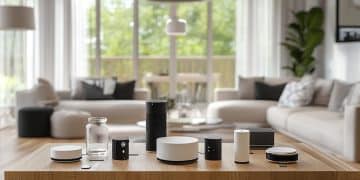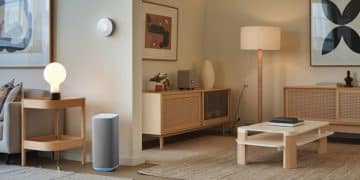Smart Lighting Guide: Control Your Home Ambiance & Save Energy
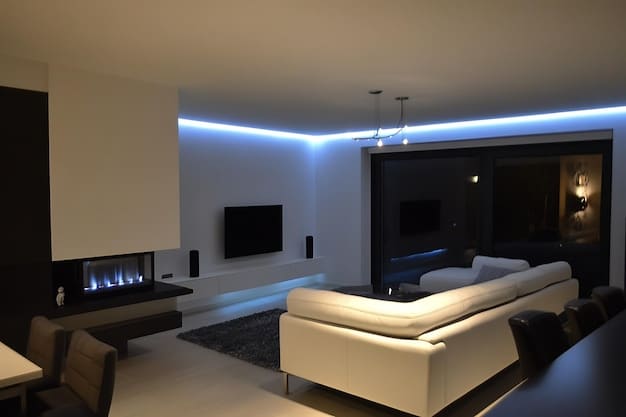
Smart lighting enhances your home’s ambiance and reduces energy consumption via automated controls and smart devices, offering customizable lighting schemes and considerable cost savings for US homeowners.
Transform your living space and cut down on energy bills with a smart lighting guide: control your US home’s ambiance and save energy. This comprehensive guide will walk you through everything you need to know to get started.
Understanding Smart Lighting Systems
Smart lighting systems are revolutionizing how we illuminate our homes. They offer more than just on/off functionality; they provide customizable, energy-efficient solutions.
Let’s delve into the core components and benefits of these systems.
Key Components of Smart Lighting
A smart lighting system essentially comprises intelligent light bulbs, a central hub (optional but recommended), and a control interface. Each element plays a crucial role in delivering a seamless experience.
- Smart Bulbs: These are LED bulbs equipped with Wi-Fi or Bluetooth capabilities, allowing remote control and customization.
- Hub or Bridge: A central device that connects all smart bulbs and devices, enabling unified control via a smartphone or voice assistant.
- Control Interface: This can be a mobile app, voice assistant (like Alexa or Google Assistant), or a smart switch, offering various ways to manage the lighting.
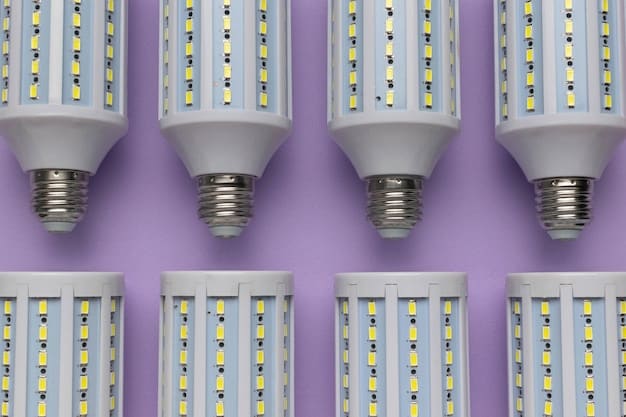
The ability to control and customize your lighting remotely is a game-changer. You can adjust brightness, change colors, and even set schedules—all from your smartphone.
Benefits of Smart Lighting
The advantages of smart lighting extend beyond mere convenience; they encompass energy savings, enhanced security, and improved ambiance.
- Energy Efficiency: Smart bulbs consume significantly less energy than traditional incandescent bulbs, leading to lower electricity bills.
- Remote Control: Adjust your lights from anywhere, ensuring energy is not wasted when rooms are unoccupied.
- Automation: Set schedules to automatically turn lights on/off, mimicking occupancy when you’re away for added security.
Smart lighting systems redefine home automation, offering unparalleled convenience, control, and energy efficiency. They transform how we interact with our living spaces, enhancing comfort and saving money.
Choosing the Right Smart Lighting for Your US Home
Selecting the perfect smart lighting system for your US home boils down to understanding your needs and preferences. Different systems cater to various lifestyles, budgets, and technological inclinations.
Let’s uncover the pertinent factors that influence this decision.
Understanding Your Needs
Consider the areas you want to illuminate, the degree of customization you desire, and your existing smart home ecosystem. These factors will guide you toward suitable options.
- Area of Illumination: Are you looking to illuminate a single room, multiple rooms, or the entire house?
- Customization Level: Do you want simple on/off control, or do you desire advanced features like color changing and scene setting?
- Smart Home Ecosystem: Which smart home platform (e.g., Apple HomeKit, Google Assistant, Amazon Alexa) do you use, and which smart lighting systems are compatible?
Different systems are optimized for different user profiles. Some users value energy efficiency above all else, while others seek maximum ambiance control.
Compatibility and Integration
Ensure that your chosen system seamlessly integrates with your existing smart home setup. Compatibility issues can lead to frustration and limited functionality.
- Compatibility with Smart Home Platforms: Ensure that the system you choose works with your preferred platform, such as Apple HomeKit, Google Assistant, or Amazon Alexa.
- Integration with Other Smart Devices: Consider how well the lighting system integrates with other smart devices like thermostats, security cameras, and smart locks.
The best fit is not always the most expensive or feature-rich. It is the system that aligns harmoniously with your existing smart home infrastructure.
Setting Up Your Smart Lighting System
Setting up your smart lighting system can be straightforward, but it pays to come prepared. A smooth installation process ensures optimal performance and prevents unnecessary headaches.
Here are the key steps to follow.
Installation Process
The process will depend on the type of system you choose, but here are some general guidelines:
- Screw in the new smart light bulbs in the desired fixtures.
- Download the corresponding app and create an account.
- Connect the hub or bridge to your home network (if required).
- Follow the app instructions to discover and configure the bulbs and devices.
Many systems offer plug-and-play installation, making it accessible even to those with limited technical expertise.
Troubleshooting Common Issues
Encountering hiccups during setup isn’t uncommon. Check for these issues:
- Connectivity Problems: Is your Wi-Fi network stable? Are the bulbs within range of the hub?
- Compatibility Issues: Are all devices compatible with your smart home platform?
- Firmware Updates: Ensure that all devices have the latest firmware installed.
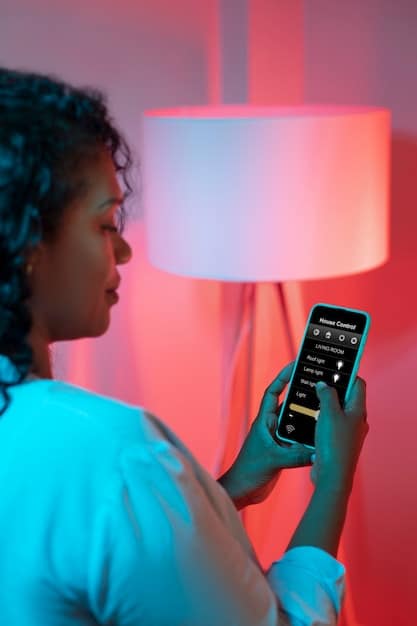
A bit of patience and methodical troubleshooting can resolve most issues. In some cases, consulting online forums or manufacturer resources can provide valuable insights.
Advanced Features and Customization
Smart lighting offers a plethora of advanced features that go beyond basic on/off control. Customization options enable you to create unique ambiance and automate lighting schemes according to your lifestyle.
Let’s explore these advanced functionalities.
Automation and Scheduling
Automation allows you to set schedules to automatically turn lights on/off or adjust brightness based on time of day, occupancy, or even sunrise/sunset.
You can also use sensors to trigger lighting based on presence detection or other conditions, conserving energy and maximizing convenience.
Color Control and Scene Setting
Many smart bulbs offer color-changing capabilities, allowing you to dial in the perfect hue for any occasion.
You can create custom scenes that combine specific colors, brightness levels, and scheduling to achieve a unique ambiance for various activities like movie night, reading, or entertaining guests.
The level of personalization is tremendous. You can tailor the lighting to any mood, occasion, or time of day.
Energy Saving Tips with Smart Lighting
Smart lighting isn’t just about aesthetics and convenience; it’s a powerful tool for energy conservation. These systems can contribute significantly to reducing your carbon footprint and lowering your utility bills.
Here are some energy-saving tips to consider.
Scheduling and Timers
Set timers to automatically turn off lights in unoccupied rooms. You can also schedule lights to dim during peak energy consumption hours.
Motion sensors can be used to trigger lights only when someone is present, preventing unnecessary illumination in vacant spaces.
Dimming and Brightness Control
Dimming lights not only creates ambiance but also reduces energy consumption. Lowering the brightness even slightly can save a significant amount of electricity.
Use brightness control to match the lighting level to your needs. Overly bright lights consume more energy than necessary.
By leveraging these simple yet effective techniques, you can maximize the energy savings potential of your smart lighting system, contributing to a more sustainable lifestyle.
Maintaining and Updating Your Smart Lighting System
Maintaining your smart lighting system ensures its longevity and optimal performance. Regular checks, software updates, and occasional troubleshooting are essential to keep everything running smoothly.
Let’s address some crucial maintenance aspects.
Software and Firmware Updates
Keep your smart lighting system software and firmware updated to ensure compatibility and access to the latest features. These updates often include bug fixes and performance enhancements.
Most systems will prompt you to install updates automatically. It’s wise to allow these updates to proceed promptly to maintain system health and stability.
Physical Maintenance and Cleaning
Dust and debris can accumulate on light bulbs and fixtures, diminishing brightness and potentially shortening the lifespan of the bulbs.
Regularly clean the bulbs and fixtures with a soft cloth to ensure optimal light output. Always disconnect the power before cleaning to prevent electrical shock.
A well-maintained system is a reliable system. Simple maintenance practices will ensure your smart lighting investment lasts for years.
| Key Feature | Brief Description |
|---|---|
| 💡 Energy Savings | LED smart bulbs use less energy, lowering electricity bills through efficient consumption. |
| 📲 Remote Control | Adjust lights from anywhere via an app, offering convenience and security while away. |
| 🏠 Home Automation | Schedule lights or integrate with smart hubs for automated lighting customized to your needs. |
| 🎨 Ambiance Control | Customize brightness and colors to enhance your home’s atmosphere and mood. |
Frequently Asked Questions (FAQ)
▼
The key components include smart bulbs (LED with Wi-Fi or Bluetooth), a central hub or bridge, and a control interface, such as a mobile app or voice assistant integration.
▼
Smart LED bulbs consume significantly less energy than traditional bulbs, often saving up to 75% in electricity costs, reducing your overall energy consumption.
▼
Yes, most smart lighting systems allow remote control via a mobile app, enabling you to adjust the light settings from anywhere with an internet connection.
▼
Many smart lighting systems are compatible with popular voice assistants, allowing you to control your lights with voice commands through devices like Amazon Echo or Google Home.
▼
It’s recommended to update your smart light software whenever updates are available to ensure optimal functionality and security, often prompted automatically by the system.
Conclusion
Smart lighting systems offer a transformative path to enhanced home ambiance, energy savings, and automation. By understanding the components, benefits, and maintenance practices, you can unlock the full potential of smart lighting and enjoy its long-lasting advantages in your US home.
